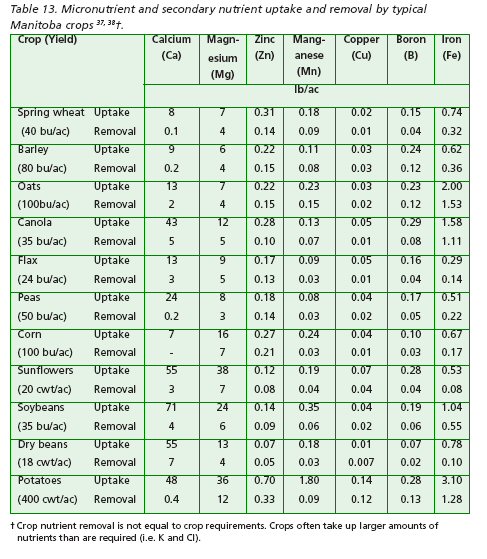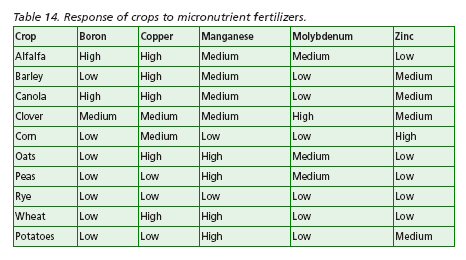Soil Fertility Guide
Micronutrients
Seven of the 16 essential plant nutrients are referred to as micronutrients; not because they are less important for plant growth and development, but because they are required in relatively small amounts (Table 13). They include: chloride (Cl), boron (B), copper (Cu), iron (Fe), manganese (Mn), molybdenum (Mo) and zinc (Zn). Table 13 also includes typical amounts of the secondary nutrients calcium and magnesium.

In Manitoba, most soils are adequately supplied with micronutrients. However, the following soil and environmental conditions may reduce micronutrient availability:
- soils low in organic matter (B, Cu and Zn)
- sandy soils (coarse texture) are more likely to be deficient than clay soils (fine textured) (Cl, Cu, Zn, B and Mo)
- peat soils or soils with over 30% organic matter (Cu, Mn and B)
- cool, wet soils reduce the rate and amount of micronutrients that can be taken up by the crop
- high soil pH reduces micronutrient availability (for all except for Mo and Cl)
- highly calcareous, high lime content soils (Zn and Fe)
- soils with exposed subsoil due to erosion or a result of land leveling (Zn)
- soils with excessive phosphorus levels (Zn)
Certain crops and even varieties may vary in sensitivity to micronutrient deficiencies. Table 14 lists crops in their response to micronutrient fertilizers when a deficiency occurs.

Highly responsive crops often respond to micronutrient fertilizer if the micronutrient concentration in the soil is low. Medium responsive crops are less likely to respond and low responsive crops do not usually respond even at the lowest micronutrient levels. In Manitoba studies, the frequency of crop response to micronutrients on mineral soils has been small.
Chlorosis in flax and soybeans
Frequently Manitoba flax 40 and soybean 41 crops exhibit chlorosis or leaf yellowing due to reduced iron availability under wet soils. Chlorosis appears as yellowing of upper leaves while veins remain green. Under severe conditions growth is stunted and yield loss occurs. These symptoms may result from a number of soil and environmental factors. Contributing factors are:
- cool, wet growing conditions
- saturated soil
- high levels of carbonates or "free lime" in the soil
- salinity
- compacted soil
Under such saturated soil conditions, iron uptake is limited when the iron ion is converted to a less available form while other minerals are increased in availability and compete for plant uptake. Application of iron micronutrients is not economical to correct this condition. Cultivars of flax and soybeans differ in their ability to tolerate chlorotic conditions; cultivar selection and improved drainage offer the best management options on suspect soils.
Chloride (CI)
Yield response to chloride has been observed in North and South Dakota. However, in research trials conducted in Manitoba, chloride fertilization has resulted in inconsistent responses, despite being conducted on soils considered deficient or marginal in chloride by American standards (< 30- 40 lb Cl/ac in 0-24" depth). Increases in grain yield by spring wheat were not consistent from year-to-year, and varied among variety 39 . A deficiency of Cl in winter wheat is visible as physiological leaf spotting. Winter wheat responses to chloride vary according to variety, and yield increases are small. Chloride is best supplied as potash (KCl) which is approximately 50% Cl.
Diagnosing Micronutrient Deficiencies
The relatively high cost of micronutrient fertilization demands accurate identification of possible deficiencies. The following steps should be taken to determine if micronutrient fertilization is warranted.
- Eliminate other possible causes of poor growth (e.g. drought, flooding, salinity, disease, herbicide injury, shortages of nitrogen, phosphorus, potassium or sulphur).
- Determine if a particular soil or crop is likely to be deficient in a micronutrient. Critical levels for several micronutrients are listed in Appendix Table 20.
- Determine if crop visual symptoms are similar to typical deficiency symptoms for specific micronutrients.
- Take separate soil and tissue samples from both affected and unaffected areas. Submit samples to a reputable lab for complete nutrient analysis. For micronutrients, tissue sampling is generally superior to soil analysis to confirm deficiencies.
- When indications suggest a micronutrient deficiency, apply such nutrients in field test strips ( Appendix Table 21). Evaluate crop recovery and yield compared to untreated areas.
Foliar micronutrient applications are often quite effective if deficiencies can be diagnosed early in growing crops. Refer to manufacturer's recommendations for rates and materials.
For further information, contact your MAFRD GO Representative.
